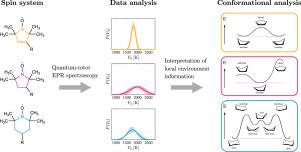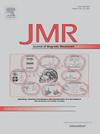利用量子转子EPR光谱揭示甲基隧穿对局部环境变化的敏感性
IF 1.9
3区 化学
Q3 BIOCHEMICAL RESEARCH METHODS
引用次数: 0
摘要
甲基转子具有作为局部环境探针的潜力,因为它们的旋转势垒对阻碍与周围环境的相互作用很敏感。量子转子电子顺磁共振(EPR)测量允许访问这个甲基转子的局部环境信息,如果它是耦合到一个电子自旋。这是常用的基于氮氧化物的自旋标签的情况,其中电子自旋回波包络调制(ESEEM)信号在低温下的不同时间尺度上表现出两种贡献。较慢的衰减贡献与基质驱动的核对ESEEM有关,而较快的衰减贡献来自电子自旋耦合甲基转子的甲基隧穿。隧道效应的ESEEM贡献包含了旋转势垒分布的局部环境信息,这些信息可以使用甲基量子转子模型进行量化。在这里,我们通过系统地研究含有两对双甲基的氮氧化物自旋探针在不同生物相关基质组成中的双脉冲ESEEM信号,来研究隧道行为对转子周围变化的敏感性。我们发现这些探针的氮氧化物环结构强烈影响观察到的甲基转子的旋转势垒,而周围的基质不影响底层的旋转势垒分布。这些见解对于设计基于氮氧化物的自旋标记作为局部环境探针与位点定向自旋标记相结合用于蛋白质结构阐明至关重要。本文章由计算机程序翻译,如有差异,请以英文原文为准。

Revealing the sensitivity of methyl tunneling towards local environment changes with quantum-rotor EPR spectroscopy
Methyl rotors have potential as local environment probes because their rotation barrier is sensitive to hindering interactions with the nearby surrounding. Quantum-rotor electron paramagnetic resonance (EPR) measurements allow access to this local environment information of the methyl rotor if it is coupled to an electron spin. This is the case for commonly used nitroxide-based spin-labels, where electron spin echo envelope modulation (ESEEM) signals exhibit two contributions on different time scales at low temperatures. The slower decaying contribution is related to matrix-driven nuclear pair ESEEM while the faster contribution originates from methyl tunneling of the electron spin-coupled methyl rotors. The tunneling ESEEM contribution contains local environment information in terms of a distribution of the rotation barrier, which can be quantified using the methyl quantum rotor model. Here, we study the sensitivity of the tunneling behavior towards changes in the rotors’ surrounding by systematically investigating the two-pulse ESEEM signal of nitroxide spin probes containing two pairs of geminal methyl groups in different biologically-relevant matrix compositions. We find that the nitroxide ring structure of these probes strongly impacts the rotation barrier of the observed methyl rotors whereas the matrix surrounding does not affect the underlying rotation barrier distribution. These insights are crucial for designing nitroxide-based spin-labels as local environments probes in combination with site-directed spin-labeling for protein structure elucidation.
求助全文
通过发布文献求助,成功后即可免费获取论文全文。
去求助
来源期刊
CiteScore
3.80
自引率
13.60%
发文量
150
审稿时长
69 days
期刊介绍:
The Journal of Magnetic Resonance presents original technical and scientific papers in all aspects of magnetic resonance, including nuclear magnetic resonance spectroscopy (NMR) of solids and liquids, electron spin/paramagnetic resonance (EPR), in vivo magnetic resonance imaging (MRI) and spectroscopy (MRS), nuclear quadrupole resonance (NQR) and magnetic resonance phenomena at nearly zero fields or in combination with optics. The Journal''s main aims include deepening the physical principles underlying all these spectroscopies, publishing significant theoretical and experimental results leading to spectral and spatial progress in these areas, and opening new MR-based applications in chemistry, biology and medicine. The Journal also seeks descriptions of novel apparatuses, new experimental protocols, and new procedures of data analysis and interpretation - including computational and quantum-mechanical methods - capable of advancing MR spectroscopy and imaging.

 求助内容:
求助内容: 应助结果提醒方式:
应助结果提醒方式:


